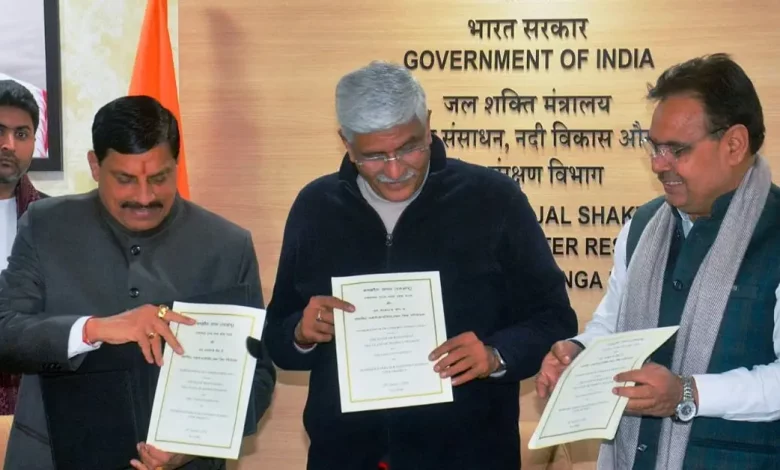Daily Current Affairs for UPSC
Modified Parbati-Kalisindh-Chambal-ERCP (Modified PKC-ERCP) Link Project
Syllabus- Science and Technology (GS Paper-3)

Context- Rajasthan and Madhya Pradesh recently signed a Memorandum of Understanding (MoU) with the Union Ministry of Jal Shakti to implement the Modified Parbati-Kalisindh-Chambal-ERCP (Modified PKC-ERCP) Link Project.
About
- The project envisages integration of the long-pending PKC river link project with the Eastern Rajasthan Canal Project, under the country wide angle plan of interlinking of rivers (ILR) programme.
- PKC: The Parbati-Kalisindh-Chambal (PKC) link project is one of the 30 links included in the National Perspectives Plan.
- ECRP: The Eastern Rajasthan Canal Project (ERCP) is aimed toward intra-basin transfer of water within the Chambal basin, by making use of surplus monsoon water.
- Linking of Both Project: Rajasthan came up with the proposal of the ERCP in 2019, and to utilise water sources optimally, the project Force for Interlinking of Rivers (TFILR) mentioned its merger with the PKC link project.
- This integration was authorised by the Special Committee for Interlinking of Rivers in 2022.
National Perspective Plan of Interlinking of Rivers (ILR) Programme
- The Government of India formulated a National Perspective Plan (NPP) for interlinking of rivers (ILR) in 1980.
- The National Water Development Agency (NWDA) has been entrusted with the work of Interlinking of Rivers under the National Perspective Plan (NPP).
- The NPP has two components, viz; Himalayan Rivers Development Component and Peninsular Rivers Development Component.
- 30 link projects have been recognized under the NPP.
- Under the Himalayan Rivers Development Component of the NPP, three link initiatives, viz; Kosi-Mechi Link project , Kosi-Ghaghra link venture and Chunar-Sone Barrage link project
- It envisages transfer of water from Kosi, Ghaghra and Gandak rivers flowing down from Nepal to the alternative rivers in the State of Bihar.
- Peninsular Rivers Development Component is split into 4 primary components:
- Interlinking of Mahanadi-Godavari-Krishna-Cauvery Rivers: This component involves interlinking of the principal river systems wherein surpluses from the Mahanadi and the Godavari are meant to be transferred to the needy areas within the south, through Krishna and Cauvery rivers.
- Interlinking of west flowing rivers, north of Bombay and south of Tapi: The scheme provides for taking water supply canal to the metropolitan areas of Mumbai; it also provides irrigation in the coastal areas in Maharashtra.
- Interlinking of Ken-Chambal: The scheme provides for a water grid for Madhya Pradesh, Rajasthan and Uttar Pradesh and an interlinking canal backed by as much storage as possible.
- Diversion of different west flowing rivers: The high rainfall at the western facet of the Western Ghats runs down into several streams which discharge into the Arabian Sea.
- The construction of an interlinking canal system backed up through good enough storage may be planned to meet all requirements of Kerala as also for switch of a few waters towards east to meet the wishes of drought affected areas.
Significance of River Linking Projects
- Reduction of Water Scarcity: Interlinking rivers can assist switch surplus water from water-rich regions to water-deficient regions, addressing water shortage issues.
- Improved Water Availability for Agriculture: Increased water availability in dry regions can enhance agricultural productivity, supporting the cultivation of crops and selling meals security.
- Mitigation of Floods: Interlinking rivers can help distribute excess water throughout durations of heavy rainfall, decreasing the risk of floods in specific regions.
- Increased Hydropower Potential: The construction of reservoirs and canals for interlinking projects can create possibilities for the hydropower generation, contributing to a cleanser and greater sustainable energy mix.
- Improved Navigation: Connecting rivers can enhance the navigability of waterways, facilitating transportation of products and decreasing the dependence on road and rail networks.
- Drought Mitigation: By redistributing water assets, interlinking projects can assist mitigate the impact of droughts through providing water to affected regions.
- Job Creation: The construction and preservation of interlinking infrastructure can create job opportunities, contributing to financial development.
- Conflict Resolution: River interlinking projects can potentially lessen inter-kingdom disputes over water resources through presenting a moreequitable distribution of water.
Concerns with the River Linking Projects
- Ecosystem Disruption: Altering natural river publications and diverting water can disrupt ecosystems, leading to habitat loss, modifications in biodiversity, and ability extinction of species.
- Displacement of Communities: The construction of dams, reservoirs, and canals for river interlinking can result in the displacement of groups, leading to social and economic hardships for affected populations.
- Inter-State Disputes: River interlinking initiatives frequently contain a couple of states, and disagreements can stand up over water sharing, mainly to inter-state disputes.
- Financial Viability: The construction of huge-scale infrastructure for river interlinking projects may be economically tough, with costs often exceeding initial estimates.
- The return on investment for such initiatives may also take a long term, raising questions about their financial viability.
- Seismic Risks: Areas susceptible to earthquakes may additionally face increased risks due to the construction of massive dams and different infrastructure related to river interlinking.
- Maintenance Issues: The right operation and preservation of the interconnected water infrastructure are vital for the success of these projects. Neglecting renovation can cause machine failures and destructive results.
- Community Resistance: Local groups and environmental activists can also oppose river interlinking projects due to concerns about their effect on the surroundings, livelihoods, and cultural history.
Conclusion
- Addressing the issues calls for complete planning, environmental impact checks, community engagement, and transparent decision-making tactics.
- Sustainable water management practices, incorporating contemporary technology and adaptive techniques, are essential to mitigate the potential negative outcomes of river interlinking projects.
Source: Indian Express





.png)



